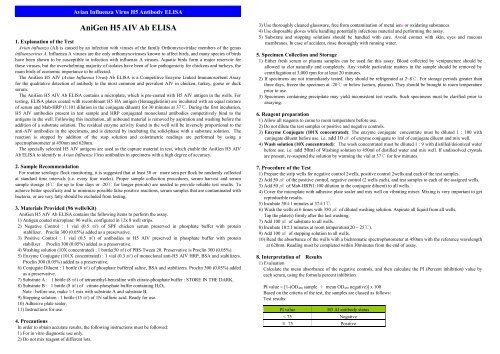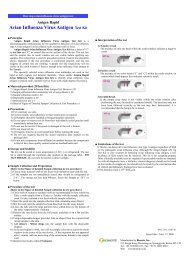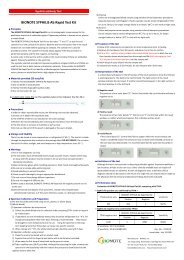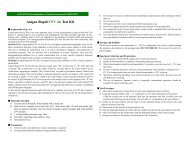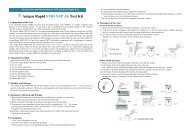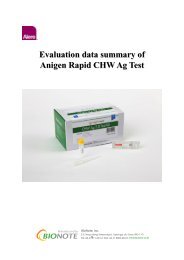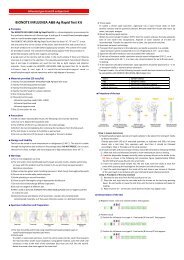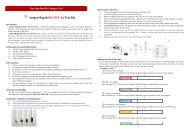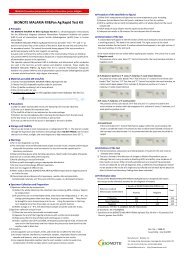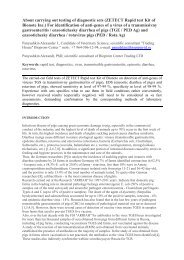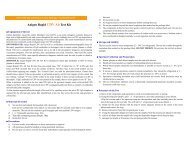AniGen H5 AIV Ab ELISA
AniGen H5 AIV Ab ELISA
AniGen H5 AIV Ab ELISA
- No tags were found...
Create successful ePaper yourself
Turn your PDF publications into a flip-book with our unique Google optimized e-Paper software.
Avian Influenza Virus <strong>H5</strong> Antibody <strong>ELISA</strong><strong>AniGen</strong> <strong>H5</strong> <strong>AIV</strong> <strong>Ab</strong> <strong>ELISA</strong>1. Explanation of the TestAvian influenza (AI) is caused by an infection with viruses of the family Orthomyxoviridae members of the genusinfluenzavirus A. Influenza A viruses are the only orthomyxoviruses known to affect birds, and many species of birdshave been shown to be susceptible to infection with influenza A viruses. Aquatic birds form a major reservoir forthese viruses, but the overwhelming majority of isolates have been of low pathogenicity for chickens and turkeys, themain birds of economic importance to be affected.The <strong>AniGen</strong> <strong>H5</strong> <strong>AIV</strong> (Avian Influenza Virus) <strong>Ab</strong> <strong>ELISA</strong> is a Competitive Enzyme Linked Immunosorbent Assayfor the qualitative detection of antibody to the most common and prevalent <strong>AIV</strong> in chicken, turkey, goose or duckserum.The <strong>AniGen</strong> <strong>H5</strong> <strong>AIV</strong> <strong>Ab</strong> <strong>ELISA</strong> contains a microplate, which is pre-coated with <strong>H5</strong> <strong>AIV</strong> antigen in the wells. Fortesting, <strong>ELISA</strong> plates coated with recombinant <strong>H5</strong> HA antigen (Hemagglutinin) are incubated with an equal mixtureof serum and Mab-HRP (1:101 dilution in the conjugate diluent) for 30 minutes at 37 ℃ . During the first incubation,<strong>H5</strong> <strong>AIV</strong> antibodies present in test sample and HRP conjugated monoclonal antibodies competitively bind to theantigens in the well. Following this incubation, all unbound material is removed by aspiration and washing before theaddition of a substrate solution. The residual enzyme activity found in the well will be inversely proportional to theanti-<strong>AIV</strong> antibodies in the specimens, and is detected by incubating the solid-phase with a substrate solution. Thereaction is stopped by addition of the stop solution and colorimetric readings are performed by using aspectrophotometer at 450nm and 620nm.The specially selected <strong>H5</strong> <strong>AIV</strong> antigens are used as the capture material in test, which enable the <strong>AniGen</strong> <strong>H5</strong> <strong>AIV</strong><strong>Ab</strong> <strong>ELISA</strong> to identify to Avian Influenza Virus antibodies in specimens with a high degree of accuracy.2. Sample RecommendationFor routine serologic flock monitoring, it is suggested that at least 30 or more sera per flock be randomly collectedat standard time intervals (i.e. every four weeks). Proper sample collection procedures, serum harvest and serumsample storage (4℃ for up to four days or -20℃for longer periods) are needed to provide reliable test results. Toachieve better specificity and to minimize possible false positive reactions, serum samples that are contaminated withbacteria, or are very fatty should be excluded from testing.3. Materials Provided (96 wells/Kit)<strong>AniGen</strong> <strong>H5</strong> <strong>AIV</strong> <strong>Ab</strong> <strong>ELISA</strong> contains the following items to perform the assay.1) Antigen coated microplate: 96 wells, configured in 12x 8 well strips.2) Negative Control : 1 vial (0.5 ml) of SPF chicken serum preserved in phosphate buffer with proteinstabilizer. Proclin 300 (0.05%) added as a preservative.3) Positive Control : 1 vial (0.5 ml) of antibodies to <strong>H5</strong> <strong>AIV</strong> preserved in phosphate buffer with proteinstabilizer . Proclin 300 (0.05%) added as a preservative.4) Washing solution (10X concentrated) : 1 bottle(50 ml) of PBS-Tween 20. Preservative is Proclin 300 (0.05%)5) Enzyme Conjugate (101X concentrated) : 1 vial (0.3 ml) of monoclonal anti-<strong>H5</strong> <strong>AIV</strong> HRP, BSA and stabilizers.Proclin 300 (0.05%) added as a preservative.6) Conjugate Diluent : 1 bottle (8 ml) of phosphate buffered saline, BSA and stabilizers. Proclin 300 (0.05%) addedas a preservative.7) Substrate A : 1 bottle (8 ml) of tetramethyl-benzidine with citrate-phosphate buffer : STORE IN THE DARK.8) Substrate B : 1 bottle (8 ml) of citrate-phosphate buffer containing H 2O 2.Note : before use, make 1:1 mix with substrate A and substrate B.9) Stopping solution : 1 bottle (15 ml) of 1N sulfuric acid. Ready for use.10) Adhesive plate sealer.11) Instructions for use.4. PrecautionsIn order to obtain accurate results, the following instructions must be followed:1) For in vitro diagnostic use only.2) Do not mix reagent of different lots.3) Use thoroughly cleaned glassware, free from contamination of metal ions or oxidating substances.4) Use disposable gloves while handling potentially infectious material and performing the assay.5) Substrate and stopping solutions should be handled with care. Avoid contact with skin, eyes and mucousmembranes. In case of accident, rinse thoroughly with running water.5. Specimen Collection and Storage1) Either fresh serum or plasma samples can be used for this assay. Blood collected by venipuncture should beallowed to clot naturally and completely. Any visible particulate matters in the sample should be removed bycentrifugation at 3,000 rpm for at least 20 minutes.2) If specimens are not immediately tested, they should be refrigerated at 2~8 ℃ . For storage periods greater thanthree days, freeze the specimen at -20℃or below (serum, plasma). They should be brought to room temperatureprior to use.3) Specimens containing precipitate may yield inconsistent test results. Such specimens must be clarified prior toassaying.6. Reagent preparation1) Allow all reagents to come to room temperature before use.2) Do not dilute the test samples or positive and negative controls.3) Enzyme Conjugate (101X concentrated): The enzyme conjugate concentrate must be diluted 1 : 100 withconjugate diluent before use. i.e. add 10 μl of enzyme conjugate to 1ml of conjugate diluent and mix well.4) Wash solution (10X concentrated): The wash concentrated must be diluted 1 : 9 with distilled/deionized waterbefore use. i.e. add 50ml of Washing solution to 450ml of distilled water and mix well. If undissolved crystalsare present, re-suspend the solution by warming the vial at 37℃for few minutes.7. Procedure of the Test1) Prepare the strip wells for negative control 2wells, positive control 2wells and each of the test samples.2) Add 50 μl of the positive control, negative control (2 wells each), and test samples to each of the assigned wells.3) Add 50 μl of Mab-HRP(1:100 dilution in the conjugate diluent) to all wells.4) Cover the microplate with adhesive plate sealer and mix well on vibrating mixer. Mixing is very important to getreproducible results.5) Incubate 30±1 minutes at 37±1 ℃ .6) Wash the wells at 6 times with 350 μl of diluted washing solution. Aspirate all liquid from all wells.Tap the plate(s) firmly after the last washing.7) Add 100 μl of substrate to all wells.8) Incubate 10±1 minutes at room temperature(20 ~ 25℃).9) Add 100 μl of stopping solution to all wells.10) Read the absorbance of the wells with a bichromatic spectrophotometer at 450nm with the reference wavelengthat 620nm. Reading must be completed within 30minutes from the end of assay.8. Interpretation of Results1) EvaluationCalculate the mean absorbance of the negative controls, and then calculate the PI (Percent inhibition) value byeach serum, using the formula percent inhibitionPI value = [1-(OD 450 sample ÷ mean OD 450 negative)] x 100Based on the criteria of the test, the samples are classed as follows:Test results:PI value<strong>H5</strong> AI antibody status< 75 Negative≥ 75Positive
2) Use the following guidelines to establish influenza antibody flock status. Please note that the <strong>ELISA</strong> is a flocktest and flock decisions should not be made on individual samples or very small flock samples (i.e. less than 10samples/flock).<strong>ELISA</strong> result Presumed Flock Status Recommended ActionAll samples negative No antibody to <strong>H5</strong> <strong>AIV</strong> None. Monitor on an ongoing basis (e.g. every week)Flock <strong>H5</strong> <strong>AIV</strong> status should be confirmed withAt least 1 sample positive Antibody to <strong>H5</strong> <strong>AIV</strong> presentadditional serological tests and virus isolation.3) Test validation1 If the OD 450 of a test sample is higher than the mean OD 450 negative, the Percentage Inhibition can beinterpreted as 0%.2 Valid <strong>H5</strong> <strong>AIV</strong> <strong>Ab</strong> <strong>ELISA</strong> results are obtained when the average optical density (OD) value of the negativecontrol is more than 1.000 and the positive control value range is less than 0.500. If either of these values areout of range , the <strong>H5</strong> <strong>AIV</strong> test results should be considered invalid and the samples should be retested.9. Limitations and Interferences1) The test procedure, precautions and interpretation of results sections for this test kit must be followed closelywhen testing.2) Samples1 Samples containing sodium azide do not affect the test result.2 Pasteurized samples (no less than 10 hours at 60 ℃ ) may lead to diminished reactivity and therefore should notbe used.3 Heat-inactivated samples (30 minutes at 56 ℃ ) do not impair the test.4 Anticoagulants such as heparin, EDTA, and citrate do not affect the test result.5 Hemolytic samples should be centrifuged before use to avoid interference by cellular constituents.6 Rheumatoid factors can lead to elevated reactivity if contained in the samples.7 Lipaemic and icteric samples do not impair the test results.3) Failure to add specimens in the procedure could result in a falsely negative test. Repeat testing should beconsidered where there is clinical suspicion of infection.10. Storage and stability1) Store at 2~8℃. This test kit is stable until the expiration date printed on the packaging and label of eachcomponent of the kit (before opening).2) Stability of once opened materials / reagentsMaterial / reagent State Storage StabilityCoated Microplate Once opened 2 ~ 8 ℃ , sealed1 monthNegative Control Once opened 2 ~ 8℃ 3 monthsPositive Control Once opened 2 ~ 8℃ 3 monthsEnzyme Conjugate Once opened 2 ~ 8℃ 1 monthConjugate Diluent Once opened 2 ~ 8℃ 1 monthWorking Conjugate 1:100 diluted Room temp. 4hoursSubstrate A Once opened 2 ~ 8℃ 1 monthSubstrate B Once opened 2 ~ 8℃ 1 monthWashing solution Once opened 2 ~ 8℃ Expiry date2 ~ 8℃ 3 monthsWorking Washing solution 1: 9 dilutedRoom temp.2 weeksStopping solution Once opened Room temp. Expiry date11. Packaging Unit96 Tests/kit, 480 Tests/kit96Test480TestsAntigen coated plate 1plate 5platesNegative Control 0.5ml X 1vial 1.5ml X 1vialPositive Control 0.5ml X 1vial 1.5ml X 1vial10X Washing Solution 50ml X 1bottle 250ml X 1bottle101X Enzyme Conjugate 0.3ml X 1vial 1.2ml X 1vialConjugate Diluent 8ml X 1bottle 30ml X 1bottleSubstrate A 8ml X 1bottle 30ml X 1bottleSubstrate B 8ml X 1bottle 30ml X 1bottleStopping Solution 15ml X 1bottle 60ml X 1bottle12. Performance characteristicsThe <strong>AniGen</strong> <strong>H5</strong> <strong>AIV</strong> <strong>Ab</strong> <strong>ELISA</strong> was tested with positive and negative clinical samples (as determined by theHemagglutination inhibition test).HemagglutinationInhibition Test<strong>AniGen</strong> <strong>H5</strong> <strong>AIV</strong> <strong>Ab</strong> <strong>ELISA</strong>Positive Negative TotalPositive 6 0 6Negative 2 1,870 1,872Total 8 1,870 1,878Relative sensitivity: 100.0%. Relative specificity: 99.9%13. PrecisionWithin-run and between-run precisions have been determined by the testing 10 replicates of three specimens: anegative serum, a low positive serum and a strong positive serum. The C.V (%) of negative, low positive, and strongpositive values were within 10%.Date Issued: Feb. 12, 2006DOC. NO.: 4503-2404-5, Woncheon-dong, Yeongtong-gu, Suwon-si, Kyonggi-do, Korea 443.Tel:82-31-211-0516, 0517 Fax:82-31-211-0537http://www.anigen.co.kr


